Nigma walckenaeri in Hull
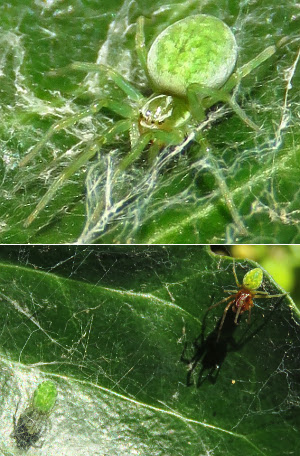 During the YNU AGM in the University of Hull last Saturday, hosted by Hull Nats, spider expert Geoff Oxford, showed us a specimen he had just collected from the University grounds: Nigma walckenaeri, a tiny and distinctive green spider that is currently expanding its range across the UK, and now colonising Yorkshire. We all admired the individual, which had been collected with its web on a curled leaf.
During the YNU AGM in the University of Hull last Saturday, hosted by Hull Nats, spider expert Geoff Oxford, showed us a specimen he had just collected from the University grounds: Nigma walckenaeri, a tiny and distinctive green spider that is currently expanding its range across the UK, and now colonising Yorkshire. We all admired the individual, which had been collected with its web on a curled leaf.
Since the meeting, I've been searching Ivy, Holly and Lilac, which are favoured bushes for the species. Nigma walckenaeri builds its little web on the top of the leaf and hides underneath. Today, I took a local walk and came across a magnificent mature Ivy, south east facing, by St Georges Road. I started searching its leaves, wondering if I had the wrong search image in my mind. It didn't take long to find a Nigma. Once I had seen one, I found another, and another, almost every ivy leaf had its little Nigma in it. The wonders of learning to see!
Females are all green, with some white bands, males have a reddish-brown cephalothorax, and green abdomen. They are very small, just 5 mm. They favour urban environments including gardens, so next time you are out and about, keep an eye for this little spider. Geoff is keen to receive records for this species on his email: Geoff.Oxford@york.ac.uk
Africa Gómez, 19 October 2022
Dark Bush-cricket, Hayburn Wyke
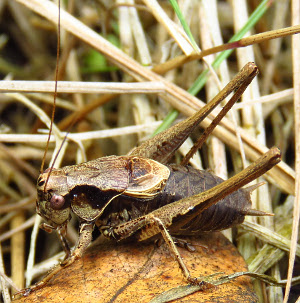
Africa Gómez, 10 September 2022
North Cave Wetlands, 14 August
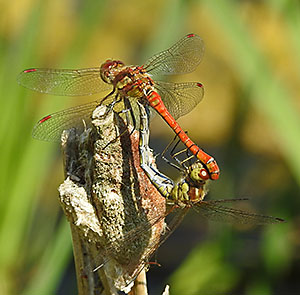 Our visit to the Wetlands coincided with the presence of a Spotted Crake which had attracted a few twitchers. With a bit of help, we managed to spot this small, nondescript bird in the reeds. Considering the time of year, there was also a reasonable selection of other water birds. Interestingly the largest numbers seemed to be in the recently excavated area that is soon to be handed over to the Trust. Thanks to the unusually hot weather there were plenty of dragonflies and butterflies active. However the heat had the opposite effect on us, so we decided to finish soon after lunch.
Our visit to the Wetlands coincided with the presence of a Spotted Crake which had attracted a few twitchers. With a bit of help, we managed to spot this small, nondescript bird in the reeds. Considering the time of year, there was also a reasonable selection of other water birds. Interestingly the largest numbers seemed to be in the recently excavated area that is soon to be handed over to the Trust. Thanks to the unusually hot weather there were plenty of dragonflies and butterflies active. However the heat had the opposite effect on us, so we decided to finish soon after lunch.
Andrew Chadwick, 15 August
photo of Common Darters, Helen Kitson
Purple Hairstreaks in the Avenues, Hull
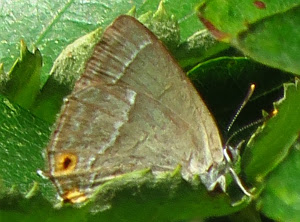 I had a most unexpected and delightful walk to work this morning; at some point I felt I was dreaming! As I was about to cross Westbourne Avenue, where a water leak has been repaired, a cyclist flushed a small butterfly from the barriers. I thought it was probably a Holly Blue, but when it settled with wings closed on the Privet hedge nearby, I realised it was a hairstreak! As I fumbled for my camera it fluttered into a front garden, where it sat with wings open. With shaking hands, I was able to take a photo, confirming the id as Purple Hairstreak!
I had a most unexpected and delightful walk to work this morning; at some point I felt I was dreaming! As I was about to cross Westbourne Avenue, where a water leak has been repaired, a cyclist flushed a small butterfly from the barriers. I thought it was probably a Holly Blue, but when it settled with wings closed on the Privet hedge nearby, I realised it was a hairstreak! As I fumbled for my camera it fluttered into a front garden, where it sat with wings open. With shaking hands, I was able to take a photo, confirming the id as Purple Hairstreak!
There is a spectacular mature Oak at the back of the adult education centre on Park Avenue not far off, and I reckoned that the wind must have made the hairstreak drift away. I carried on by Jack Kaye fields where there was a Speckled Wood by the entrance, near the Oak. I counted six Speckled Woods here and then moved into the glade, where a small butterfly settled on a Whitebeam to bask. I focused my camera and it was another Purple Hairstreak with wings closed, well settled (above).
This tiny butterfly, a lovers of tree canopies and honeydew, is probably being under-recorded; keep looking at oaks!
Africa Gómez, 4 August 2022
Reighton Gap, 2 July
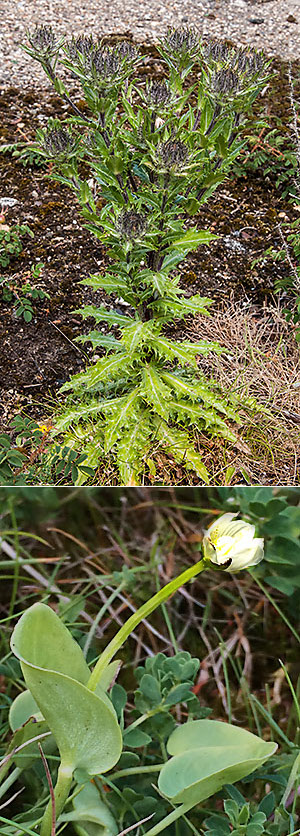 A select few attended the Reighton Gap field meeting. We explored the cliff top, where a couple of ponds have been created, before descending to the beach and looking at some of the undercliff areas. There was a good variety of species with plenty of Pyramidal and Common-spotted Orchids and a few Bee Orchids. However we didn’t manage to find the Fragrant Orchids. We did find Grass-of-Parnassus (bottom picture) and some very healthy Carline Thistles (top), neither yet fully in flower. On a damp area on the undercliff there was a patch of Marsh Arrowgrass. Not much bird activity but a reasonable selection of butterflies were seen. An additional bonus for me was an introduction to the geology of the cliffs and the Speeton & Kimmeridge Clay layers that are exposed here. No major fossil finds though - apart from those present.
A select few attended the Reighton Gap field meeting. We explored the cliff top, where a couple of ponds have been created, before descending to the beach and looking at some of the undercliff areas. There was a good variety of species with plenty of Pyramidal and Common-spotted Orchids and a few Bee Orchids. However we didn’t manage to find the Fragrant Orchids. We did find Grass-of-Parnassus (bottom picture) and some very healthy Carline Thistles (top), neither yet fully in flower. On a damp area on the undercliff there was a patch of Marsh Arrowgrass. Not much bird activity but a reasonable selection of butterflies were seen. An additional bonus for me was an introduction to the geology of the cliffs and the Speeton & Kimmeridge Clay layers that are exposed here. No major fossil finds though - apart from those present.
Andrew Chadwick, 2 July 2022
Osprey over Hull
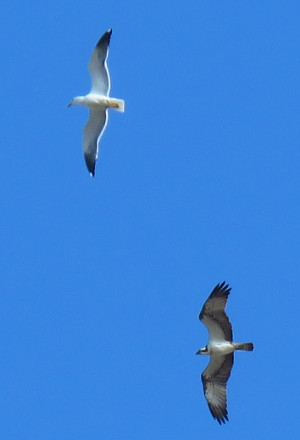 Yesterday, while on my way to work, along Newland avenue I heard a Lesser Black-backed Gull sounding an alarm. I saw what I thought were two gulls chasing high up, but looking again, one of them looked a bit odd so I took some photos and I was pleasantly surprised it was an Osprey! I didn’t manage to get a single focused photo after that, as the Osprey drifted to the SW; excitement does that to you! I put it on social media right away and apparently the same individual was seen by the Far Ings warden shortly afterwards. An individual has been seen wandering around Hornsea Mere and Brandesburton in the last couple of weeks, which might be the same bird I saw. Always worth listening for gull alarm calls!
Yesterday, while on my way to work, along Newland avenue I heard a Lesser Black-backed Gull sounding an alarm. I saw what I thought were two gulls chasing high up, but looking again, one of them looked a bit odd so I took some photos and I was pleasantly surprised it was an Osprey! I didn’t manage to get a single focused photo after that, as the Osprey drifted to the SW; excitement does that to you! I put it on social media right away and apparently the same individual was seen by the Far Ings warden shortly afterwards. An individual has been seen wandering around Hornsea Mere and Brandesburton in the last couple of weeks, which might be the same bird I saw. Always worth listening for gull alarm calls!
Africa Gómez, 10 June 2022
BSBI New Year Plant Hunt (1)
Hull. On New Year’s Day I started a solo plant hunt on Princes Avenue, where the neglected flowerbeds were surprisingly productive. Thereafter I combed the pavements, terraces and tenfoots off Newland Avenue, for the usual urban mix mix of waste ground species, common wildflowers and the more frequent garden escapees. Sculcoates was a disappointment as the Council have recently fenced and paved the small terraces – not a weed in sight! - but Mexican Fleabane was still there high up on a factory wall. The biggest surprise was by the river at industrial Wincolmlee where Cornflower, Fiddleneck, Field Pansy and an "improved" arable Red Clover (var. sativa) were in full bloom, escapees from a wildflower mix persisting as roadside casuals. Total 49.
Hessle on 3rd January with John Killingbeck, was fairly deserted. Sainsbury’s car park, Priory Park and Ride and the grassy slopes surrounding the motor car franchises, all close together, in a very short time yielded well over 50 species, notably Narrow-leaved Ragwort, Gorse, Black Medick, Cornsalad, Catsear, Pellitory-of-the-Wall, Hedge Bindweed, Red Campion. Urban Hessle, including the churchyard, was disappointing. Total 57.
Gabrielle Jarvis, 10 January 2022
BSBI New Year Plant Hunt (2)
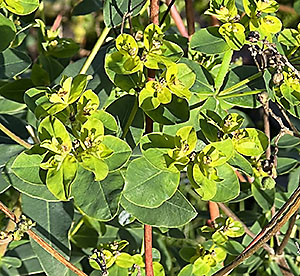 Also on January 3rd another group of four members had a pleasant wander around the Grovehill Road / Beverley Beck area, exploring as many interesting alleys and passages as possible. Despite our efforts the final total was only 31. The most unusual find was Balkan Spurge (Euphorbia oblongata) (see above photo), naturalised on waste ground. This was accepted as a new BSBI vice-county record.
Also on January 3rd another group of four members had a pleasant wander around the Grovehill Road / Beverley Beck area, exploring as many interesting alleys and passages as possible. Despite our efforts the final total was only 31. The most unusual find was Balkan Spurge (Euphorbia oblongata) (see above photo), naturalised on waste ground. This was accepted as a new BSBI vice-county record.
Andrew Chadwick, 10 January 2022
Orange Peel Fugus
 John Killingbeck and I found this Orange Peel Fungus (Aleuria aurantia) growing in the middle of an arable field above North Cliffe. It was quite widespread at one corner.
John Killingbeck and I found this Orange Peel Fungus (Aleuria aurantia) growing in the middle of an arable field above North Cliffe. It was quite widespread at one corner.
Gabrielle Jarvis, 1 December 2022
Crickets in Hull
I have been visiting several brownfield sites near home in the last week in search of bush-crickets, which are colonising the Hull area at full speed. We found a Southern Oak Bush-cricket on the pavement at the end of Marlborough Avenue on Saturday under the large Ash tree. Then I visited the Amazing Community Garden at the end of Middleton Street, where I found Long-winged Coneheads (the site gave the 1st Hull record in 2018 by Andy Gibson). The MKM Stadium delivered with both Roesel's and Long-winged Coneheads (previously found there by Barry Warrington), and this afternoon an hour was well spent during sunny spells at Jack Kaye Fields, where I found my own colony of five Long-winged Coneheads, with 2 nymphs indicating established population and a male stridulating, and a large population of the spider Araneus quadratus, a species I don't often see in Hull. The best find was not a small toad, but a Roesel's Bush-cricket, which didn't pose much for photos, but scurried into a large grass tussock. I am totally cricket-deaf, so I can only imagine the riot of song that must be happening in all these sites. I must get a bat detector!
I would be very interested to receive any records of local Orthoptera.
Africa Gómez, 9 September 2022
Crickets in Hull (2)
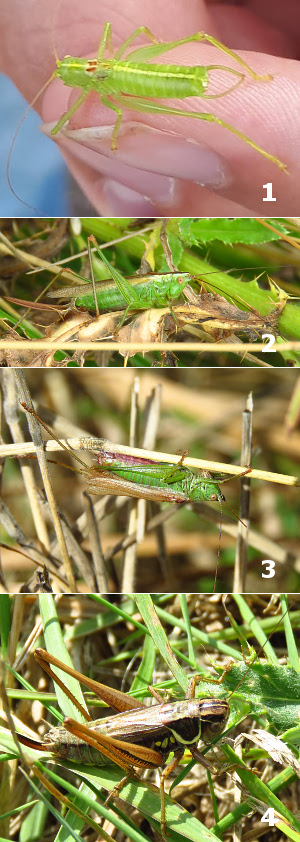
- Southern Oak Bush-cricket
- Long-winged Conehead (♀), Amazing Community Garden
- Long-winged Conehead (♂), Jack Kaye Fields
- Roesel's Bush-cricket
Africa Gómez, 9 September 2022
Des Etangs' St John's-wort confirmed
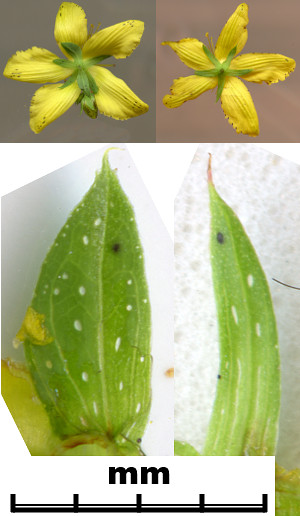 On our evening field meeting 7 June we examined the splendid roadside verge, to the north of Ings Cottages, between Benningholme and Arnold. In 1979 Eva Crackles found Hypericum x desetangsii, the uncommon, fertile, hybrid between Perforate St John's-wort (H. perforatum) and Imperforate St John's-wort (H. maculatum), growing here. Since Imperforate St John's-wort is not reliably known to have occurred in East Yorkshire, it's presence in this "natural" setting is rather puzzling - other local occurrences are often associated with imported ballast.
On our evening field meeting 7 June we examined the splendid roadside verge, to the north of Ings Cottages, between Benningholme and Arnold. In 1979 Eva Crackles found Hypericum x desetangsii, the uncommon, fertile, hybrid between Perforate St John's-wort (H. perforatum) and Imperforate St John's-wort (H. maculatum), growing here. Since Imperforate St John's-wort is not reliably known to have occurred in East Yorkshire, it's presence in this "natural" setting is rather puzzling - other local occurrences are often associated with imported ballast.
During our survey a small, non-flowering, patch of St John's-wort was found which bore leaves with only a few scattered translucent glands - the "perforations" normally so obvious in our most common species. In the BSBI Plant Crib (Rich & Jermy, 1998) it is acknowledged that there is so much variation shown by this hybid that the sepals are the safest single character to use in its determination.
After ten days on the windowsill in a glass of water, a voucher specimen managed to produce a flower (above left). Unfortunately I had to wait another week before my garden could produce a flower of Perforate St John's-wort to use as a comparison (above right).The confirmation of this important local plant, which I suspected by the sparseness of "perforations", can now be positively confirmed by its broader sepals, and traces of denticulation at their more obtuse tip (lower pair of pictures).
Richard Middleton, 26 June 2022
Sinnington, 14 May
with Ryedale Natural History Society
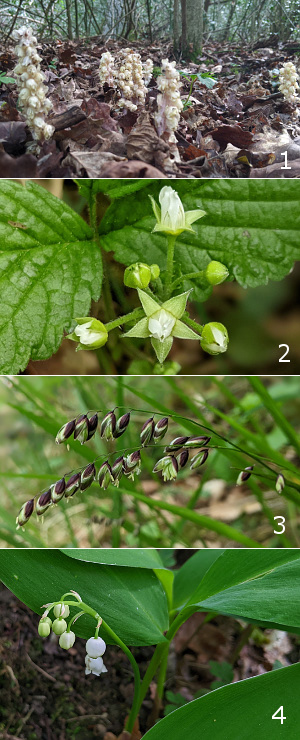 Twelve of us set off from the green on a fine sunny day to explore the steep wooded valley east of the river as far as Appleton Mill. Our path climbed a hollow way, then descended steeply through ancient woodland and meadows down to the river. We encountered a variety of habitats; the underlying rock is mainly limestone with a rich calcicole flora but there is also some sandstone, allowing acid-tolerant plants like Wood-sorrel to flourish. Below the level of the Bluebells, Ramsons was the dominant species right on to the river bank.
Twelve of us set off from the green on a fine sunny day to explore the steep wooded valley east of the river as far as Appleton Mill. Our path climbed a hollow way, then descended steeply through ancient woodland and meadows down to the river. We encountered a variety of habitats; the underlying rock is mainly limestone with a rich calcicole flora but there is also some sandstone, allowing acid-tolerant plants like Wood-sorrel to flourish. Below the level of the Bluebells, Ramsons was the dominant species right on to the river bank.
Botanical finds included Toothwort, Goldilocks Buttercup, Hard Shield-fern, Hard-fern, Early-purple Orchid, False Oxlip and Sanicle. But the real rarities, Stone Bramble, Mountain Melick and Lily-of-the-valley were found only at the lowest level of the wood.
Plenty of insects were recorded, perhaps the most notable being the Hairy-footed Flower Bee and its kleptoparasite the Mourning Bee. Swifts screamed high overhead and a Grey Wagtail was seen by the river.
Photographs -
- Toothwort
- Stone Bramble
- Mountain Melick
- Lily-of-the-valley
Gabrielle Jarvis, 23 May 2022
Photographs by Helen Kitson
Stone Creek, 26 March
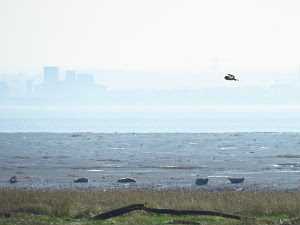 A sunny, mild day with barely a breeze, we visit Stone Creek, a small, sheltered creek off the Humber, where several main drains enter the estuary. The tide is low and we walk west to have the sun on our backs. We spot several Meadow Pipits, Reed Buntings and Yellowhammers, but it is quiet bird-wise. We return via the road and before leaving, we try to find some lizards on the flood bank. Instead, we see a Short-eared Owl, and while watching it we spot seven Common Seals. It is a fitting end to the day to end up watching the seals, perched on the edge of the creek, with the Short-eared Owl flying above them.
A sunny, mild day with barely a breeze, we visit Stone Creek, a small, sheltered creek off the Humber, where several main drains enter the estuary. The tide is low and we walk west to have the sun on our backs. We spot several Meadow Pipits, Reed Buntings and Yellowhammers, but it is quiet bird-wise. We return via the road and before leaving, we try to find some lizards on the flood bank. Instead, we see a Short-eared Owl, and while watching it we spot seven Common Seals. It is a fitting end to the day to end up watching the seals, perched on the edge of the creek, with the Short-eared Owl flying above them.
Africa Gómez, 27 March 2022
Hair Ice
 I was lucky enough to spot this 'Hair Ice' on a rotting branch at Beggar’s Bridge in Glaisdale in December.
I was lucky enough to spot this 'Hair Ice' on a rotting branch at Beggar’s Bridge in Glaisdale in December.
It's an uncommon sight because of the specific conditions under which it forms. First, it only occurs on rotting wood hosting the thin jelly fungus Exidiopsis effusa. Second, it needs specific conditions of environment and weather: a damp place where the temperature has suddenly dropped to just under 0° C.
Alfred Wegener first proposed the connection between Hair Ice and fungus in 1918 but it took a century for a group of German scientists to study the process in detail, involving 'ice segregation' on the wood surface, whereby traces of lignin and tannin, released during fungal decomposition, are sucked into the ice crystals. Hair Ice can grow up to 20 cm and form spectacular 'tresses'. Mine was a more modest example of around 5 cm, but still an exciting find.
- Met Office. Hair Ice.
-
SCI-NEWS website (2015). European Biologists Finally Solve Mystery of Hair Ice.
Helen Kitson, 1 January 2022
Autumn colour in Wawne
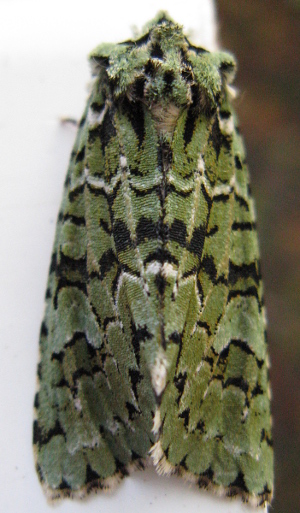 By mid-October the contents of my moth trap are rather sparse and usually decidedly brown. Yesterday morning I was rewarded with one of our most beautiful moths - this superb Merveille du Jour (above). It certainly was the "wonder of the day".
By mid-October the contents of my moth trap are rather sparse and usually decidedly brown. Yesterday morning I was rewarded with one of our most beautiful moths - this superb Merveille du Jour (above). It certainly was the "wonder of the day".
Richard Middleton, 19 October 2022
Some autumn moths from Wawne

- Red-green Carpet
- Black Rustic
- Beaded Chestnut
Richard Middleton, 20 September 2022
Mission accomplished ...
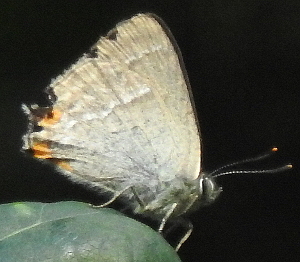 Yesterday evening (26 July) members of the Society managed to find several specimens of the Purple Hairstreak butterfly on the Oak trees outside Burton Bushes during a meeting arranged specifically with this objective.
Yesterday evening (26 July) members of the Society managed to find several specimens of the Purple Hairstreak butterfly on the Oak trees outside Burton Bushes during a meeting arranged specifically with this objective.
This infrequent East Yorkshire butterfly is known to have occurred here in the past but it has not been recorded at the site for a while.
(Long-distance) photograph by Helen Kitson,
27 July 2022
Burton Bushes, 26 July
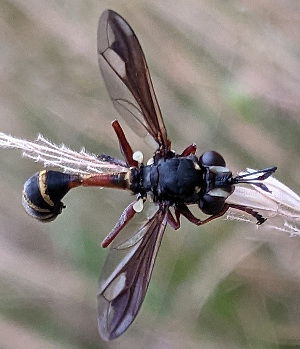 Another interesting insect find in Burton Bushes was the pictured Conopid fly, Physocephala rufipes. Attractive and weirdly waisted like a hunting wasp, the adults feed on nectar, but have gruesome reproductive habits. The female Conopid (aka bee-grabber) will jump on a passing bumble or honeybee, prise open an abdominal segment and oviposit inside the bee. The larvae then eat the bee alive, before emerging from the corpse the following spring.
Another interesting insect find in Burton Bushes was the pictured Conopid fly, Physocephala rufipes. Attractive and weirdly waisted like a hunting wasp, the adults feed on nectar, but have gruesome reproductive habits. The female Conopid (aka bee-grabber) will jump on a passing bumble or honeybee, prise open an abdominal segment and oviposit inside the bee. The larvae then eat the bee alive, before emerging from the corpse the following spring.
Helen Kitson, 27 July 2022
Muntjac deer, Muntiacus reevesi
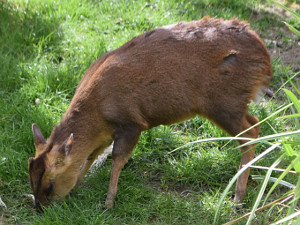 This species is spreading northwards in the UK, and is one of just eight non-native animal species to which the following UK legislation applies: The Invasive Alien Species (Enforcement and Permitting) Order 2019.
This species is spreading northwards in the UK, and is one of just eight non-native animal species to which the following UK legislation applies: The Invasive Alien Species (Enforcement and Permitting) Order 2019.
Recently, I have been made aware of two reports of Muntjac deer close to South Cave and Brantingham. One was seen at the beginning of April by an experienced deer watcher, who also had been told of a local road kill about six months ago. Interestingly, there are other records of Muntjac in the Brough - Market Weighton area: in Brough (2022) during a night-time bird survey, near HM Prison Humber (2013), at North Cliffe (including an animal shot in 2014) and on a farm near Shiptonthorpe (2018). These details are based on information from Dan Lombard, NBN Atlas and iRecord. Other VC 61 locations include Weel (2015), near Warter (2021) and near Sledmere (2007). For the national distribution of Muntjac, see the results of the British Deer Society survey in 2016 . A useful ID guide to the species can be found on the GB Non-native Species Secretariat (NNSS) website.
Richard Shillaker, 20 April 2022
Photograph (not taken locally) by Chris Manning
Messingham, 24 April
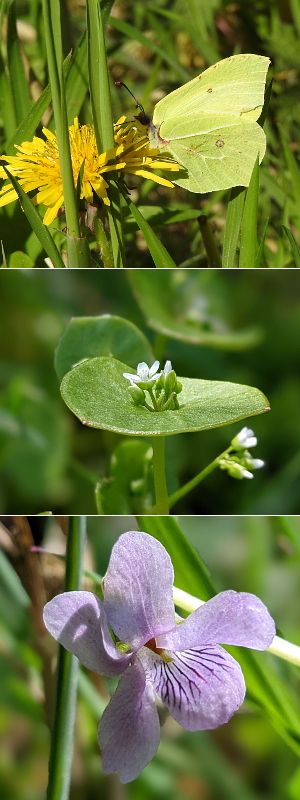 Eight members enjoyed a very sunny day at Messingham, last visited in 2014. Although only late April, there were plenty of flowers, including Meadow Saxifrage, Springbeauty, Cowslips and Marsh Marigolds and one or two Marsh Violets. Most of the warblers had returned with Blackcap, Willow Warbler and Chiffchaff and Reed Warbler making themselves heard, occasionally being drowned out by Cetti’s Warbler. Sand Martins and Swallows were also seen. A small group of Avocets and a few Common Terns were the highlight amongst a range of the usual water birds. The sunshine also brought out eight species of butterfly.
Eight members enjoyed a very sunny day at Messingham, last visited in 2014. Although only late April, there were plenty of flowers, including Meadow Saxifrage, Springbeauty, Cowslips and Marsh Marigolds and one or two Marsh Violets. Most of the warblers had returned with Blackcap, Willow Warbler and Chiffchaff and Reed Warbler making themselves heard, occasionally being drowned out by Cetti’s Warbler. Sand Martins and Swallows were also seen. A small group of Avocets and a few Common Terns were the highlight amongst a range of the usual water birds. The sunshine also brought out eight species of butterfly.
Photographs -
- Brimstone butterfly
- Springbeauty
- Marsh Violet
Andrew Chadwick, 25 April 2022
Photographs by Helen Kitson
Siskin, Waters' Edge Country Park
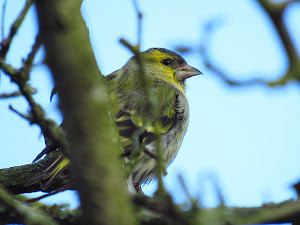
Africa Gómez, 22 January 2022
 During the YNU AGM in the University of Hull last Saturday, hosted by Hull Nats, spider expert Geoff Oxford, showed us a specimen he had just collected from the University grounds: Nigma walckenaeri, a tiny and distinctive green spider that is currently expanding its range across the UK, and now colonising Yorkshire. We all admired the individual, which had been collected with its web on a curled leaf.
During the YNU AGM in the University of Hull last Saturday, hosted by Hull Nats, spider expert Geoff Oxford, showed us a specimen he had just collected from the University grounds: Nigma walckenaeri, a tiny and distinctive green spider that is currently expanding its range across the UK, and now colonising Yorkshire. We all admired the individual, which had been collected with its web on a curled leaf. 


 Our visit to the Wetlands coincided with the presence of a Spotted Crake which had attracted a few twitchers. With a bit of help, we managed to spot this small, nondescript bird in the reeds. Considering the time of year, there was also a reasonable selection of other water birds. Interestingly the largest numbers seemed to be in the recently excavated area that is soon to be handed over to the Trust. Thanks to the unusually hot weather there were plenty of dragonflies and butterflies active. However the heat had the opposite effect on us, so we decided to finish soon after lunch.
Our visit to the Wetlands coincided with the presence of a Spotted Crake which had attracted a few twitchers. With a bit of help, we managed to spot this small, nondescript bird in the reeds. Considering the time of year, there was also a reasonable selection of other water birds. Interestingly the largest numbers seemed to be in the recently excavated area that is soon to be handed over to the Trust. Thanks to the unusually hot weather there were plenty of dragonflies and butterflies active. However the heat had the opposite effect on us, so we decided to finish soon after lunch.
 I had a most unexpected and delightful walk to work this morning; at some point I felt I was dreaming! As I was about to cross Westbourne Avenue, where a water leak has been repaired, a cyclist flushed a small butterfly from the barriers. I thought it was probably a Holly Blue, but when it settled with wings closed on the Privet hedge nearby, I realised it was a hairstreak! As I fumbled for my camera it fluttered into a front garden, where it sat with wings open. With shaking hands, I was able to take a photo, confirming the id as Purple Hairstreak!
I had a most unexpected and delightful walk to work this morning; at some point I felt I was dreaming! As I was about to cross Westbourne Avenue, where a water leak has been repaired, a cyclist flushed a small butterfly from the barriers. I thought it was probably a Holly Blue, but when it settled with wings closed on the Privet hedge nearby, I realised it was a hairstreak! As I fumbled for my camera it fluttered into a front garden, where it sat with wings open. With shaking hands, I was able to take a photo, confirming the id as Purple Hairstreak!  A select few attended the Reighton Gap field meeting. We explored the cliff top, where a couple of ponds have been created, before descending to the beach and looking at some of the undercliff areas. There was a good variety of species with plenty of Pyramidal and Common-spotted Orchids and a few Bee Orchids. However we didn’t manage to find the Fragrant Orchids. We did find Grass-of-Parnassus (bottom picture) and some very healthy Carline Thistles (top), neither yet fully in flower. On a damp area on the undercliff there was a patch of Marsh Arrowgrass. Not much bird activity but a reasonable selection of butterflies were seen. An additional bonus for me was an introduction to the geology of the cliffs and the Speeton & Kimmeridge Clay layers that are exposed here. No major fossil finds though - apart from those present.
A select few attended the Reighton Gap field meeting. We explored the cliff top, where a couple of ponds have been created, before descending to the beach and looking at some of the undercliff areas. There was a good variety of species with plenty of Pyramidal and Common-spotted Orchids and a few Bee Orchids. However we didn’t manage to find the Fragrant Orchids. We did find Grass-of-Parnassus (bottom picture) and some very healthy Carline Thistles (top), neither yet fully in flower. On a damp area on the undercliff there was a patch of Marsh Arrowgrass. Not much bird activity but a reasonable selection of butterflies were seen. An additional bonus for me was an introduction to the geology of the cliffs and the Speeton & Kimmeridge Clay layers that are exposed here. No major fossil finds though - apart from those present.
 Yesterday, while on my way to work, along Newland avenue I heard a Lesser Black-backed Gull sounding an alarm. I saw what I thought were two gulls chasing high up, but looking again, one of them looked a bit odd so I took some photos and I was pleasantly surprised it was an Osprey! I didn’t manage to get a single focused photo after that, as the Osprey drifted to the SW; excitement does that to you! I put it on social media right away and apparently the same individual was seen by the Far Ings warden shortly afterwards. An individual has been seen wandering around Hornsea Mere and Brandesburton in the last couple of weeks, which might be the same bird I saw. Always worth listening for gull alarm calls!
Yesterday, while on my way to work, along Newland avenue I heard a Lesser Black-backed Gull sounding an alarm. I saw what I thought were two gulls chasing high up, but looking again, one of them looked a bit odd so I took some photos and I was pleasantly surprised it was an Osprey! I didn’t manage to get a single focused photo after that, as the Osprey drifted to the SW; excitement does that to you! I put it on social media right away and apparently the same individual was seen by the Far Ings warden shortly afterwards. An individual has been seen wandering around Hornsea Mere and Brandesburton in the last couple of weeks, which might be the same bird I saw. Always worth listening for gull alarm calls!
 Also on January 3rd another group of four members had a pleasant wander around the Grovehill Road / Beverley Beck area, exploring as many interesting alleys and passages as possible. Despite our efforts the final total was only 31. The most unusual find was Balkan Spurge (Euphorbia oblongata) (see above photo), naturalised on waste ground. This was accepted as a new BSBI vice-county record.
Also on January 3rd another group of four members had a pleasant wander around the Grovehill Road / Beverley Beck area, exploring as many interesting alleys and passages as possible. Despite our efforts the final total was only 31. The most unusual find was Balkan Spurge (Euphorbia oblongata) (see above photo), naturalised on waste ground. This was accepted as a new BSBI vice-county record. John Killingbeck and I found this Orange Peel Fungus (Aleuria aurantia) growing in the middle of an arable field above North Cliffe. It was quite widespread at one corner.
John Killingbeck and I found this Orange Peel Fungus (Aleuria aurantia) growing in the middle of an arable field above North Cliffe. It was quite widespread at one corner.

 On our evening field meeting 7 June we examined the splendid roadside verge, to the north of Ings Cottages, between Benningholme and Arnold. In 1979 Eva Crackles found Hypericum x desetangsii, the uncommon, fertile, hybrid between Perforate St John's-wort (H. perforatum) and Imperforate St John's-wort (H. maculatum), growing here. Since Imperforate St John's-wort is not reliably known to have occurred in East Yorkshire, it's presence in this "natural" setting is rather puzzling - other local occurrences are often associated with imported ballast.
On our evening field meeting 7 June we examined the splendid roadside verge, to the north of Ings Cottages, between Benningholme and Arnold. In 1979 Eva Crackles found Hypericum x desetangsii, the uncommon, fertile, hybrid between Perforate St John's-wort (H. perforatum) and Imperforate St John's-wort (H. maculatum), growing here. Since Imperforate St John's-wort is not reliably known to have occurred in East Yorkshire, it's presence in this "natural" setting is rather puzzling - other local occurrences are often associated with imported ballast. Twelve of us set off from the green on a fine sunny day to explore the steep wooded valley east of the river as far as Appleton Mill. Our path climbed a hollow way, then descended steeply through ancient woodland and meadows down to the river. We encountered a variety of habitats; the underlying rock is mainly limestone with a rich calcicole flora but there is also some sandstone, allowing acid-tolerant plants like Wood-sorrel to flourish. Below the level of the Bluebells, Ramsons was the dominant species right on to the river bank.
Twelve of us set off from the green on a fine sunny day to explore the steep wooded valley east of the river as far as Appleton Mill. Our path climbed a hollow way, then descended steeply through ancient woodland and meadows down to the river. We encountered a variety of habitats; the underlying rock is mainly limestone with a rich calcicole flora but there is also some sandstone, allowing acid-tolerant plants like Wood-sorrel to flourish. Below the level of the Bluebells, Ramsons was the dominant species right on to the river bank. A sunny, mild day with barely a breeze, we visit Stone Creek, a small, sheltered creek off the Humber, where several main drains enter the estuary. The tide is low and we walk west to have the sun on our backs. We spot several Meadow Pipits, Reed Buntings and Yellowhammers, but it is quiet bird-wise. We return via the road and before leaving, we try to find some lizards on the flood bank. Instead, we see a Short-eared Owl, and while watching it we spot seven Common Seals. It is a fitting end to the day to end up watching the seals, perched on the edge of the creek, with the Short-eared Owl flying above them.
A sunny, mild day with barely a breeze, we visit Stone Creek, a small, sheltered creek off the Humber, where several main drains enter the estuary. The tide is low and we walk west to have the sun on our backs. We spot several Meadow Pipits, Reed Buntings and Yellowhammers, but it is quiet bird-wise. We return via the road and before leaving, we try to find some lizards on the flood bank. Instead, we see a Short-eared Owl, and while watching it we spot seven Common Seals. It is a fitting end to the day to end up watching the seals, perched on the edge of the creek, with the Short-eared Owl flying above them.
 I was lucky enough to spot this 'Hair Ice' on a rotting branch at Beggar’s Bridge in Glaisdale in December.
I was lucky enough to spot this 'Hair Ice' on a rotting branch at Beggar’s Bridge in Glaisdale in December.  By mid-October the contents of my moth trap are rather sparse and usually decidedly brown. Yesterday morning I was rewarded with one of our most beautiful moths - this superb Merveille du Jour (above). It certainly was the "wonder of the day".
By mid-October the contents of my moth trap are rather sparse and usually decidedly brown. Yesterday morning I was rewarded with one of our most beautiful moths - this superb Merveille du Jour (above). It certainly was the "wonder of the day".

 Yesterday evening (26 July) members of the Society managed to find several specimens of the Purple Hairstreak butterfly on the Oak trees outside Burton Bushes during a meeting arranged specifically with this objective.
Yesterday evening (26 July) members of the Society managed to find several specimens of the Purple Hairstreak butterfly on the Oak trees outside Burton Bushes during a meeting arranged specifically with this objective. Another interesting insect find in Burton Bushes was the pictured Conopid fly, Physocephala rufipes. Attractive and weirdly waisted like a hunting wasp, the adults feed on nectar, but have gruesome reproductive habits. The female Conopid (aka bee-grabber) will jump on a passing bumble or honeybee, prise open an abdominal segment and oviposit inside the bee. The larvae then eat the bee alive, before emerging from the corpse the following spring.
Another interesting insect find in Burton Bushes was the pictured Conopid fly, Physocephala rufipes. Attractive and weirdly waisted like a hunting wasp, the adults feed on nectar, but have gruesome reproductive habits. The female Conopid (aka bee-grabber) will jump on a passing bumble or honeybee, prise open an abdominal segment and oviposit inside the bee. The larvae then eat the bee alive, before emerging from the corpse the following spring.
 This species is spreading northwards in the UK, and is one of just eight non-native animal species to which the following UK legislation applies: The Invasive Alien Species (Enforcement and Permitting) Order 2019.
This species is spreading northwards in the UK, and is one of just eight non-native animal species to which the following UK legislation applies: The Invasive Alien Species (Enforcement and Permitting) Order 2019. Eight members enjoyed a very sunny day at Messingham, last visited in 2014. Although only late April, there were plenty of flowers, including Meadow Saxifrage, Springbeauty, Cowslips and Marsh Marigolds and one or two Marsh Violets. Most of the warblers had returned with Blackcap, Willow Warbler and Chiffchaff and Reed Warbler making themselves heard, occasionally being drowned out by Cetti’s Warbler. Sand Martins and Swallows were also seen. A small group of Avocets and a few Common Terns were the highlight amongst a range of the usual water birds. The sunshine also brought out eight species of butterfly.
Eight members enjoyed a very sunny day at Messingham, last visited in 2014. Although only late April, there were plenty of flowers, including Meadow Saxifrage, Springbeauty, Cowslips and Marsh Marigolds and one or two Marsh Violets. Most of the warblers had returned with Blackcap, Willow Warbler and Chiffchaff and Reed Warbler making themselves heard, occasionally being drowned out by Cetti’s Warbler. Sand Martins and Swallows were also seen. A small group of Avocets and a few Common Terns were the highlight amongst a range of the usual water birds. The sunshine also brought out eight species of butterfly.